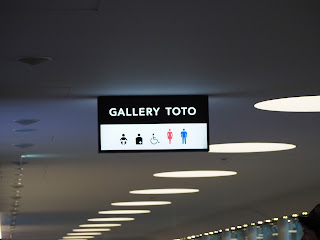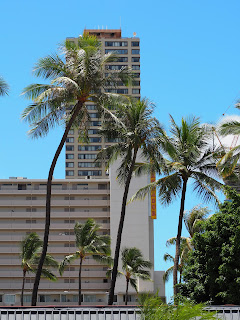Continuing on South, the road winds around the natural Lelu harbour, through banana farms and barely restrained jungle into the marvellously underwhelming capital city of Tofol.
I have probably missed some vital information as to why such a small location is, in fact, the capital, but it does house a post office, the governor's house and the visitor's bureau.
It also has a small path leading up the hill to a secluded watermelon farm that offers a wonderful view down onto Lelu harbour area and Kosrae's brand new solar power farm.
There is also a small grove of the Australian gum eucalyptus with rainbow-coloured bark, clashing rather violently with the otherwise bushy and brilliant green jungle.
Further along the coast, I finally came to the famous abandoned tank. Or at least, after wandering up and down the coast a little more to verify that there were no other obvious tanks, I had to admit that this was indeed the famous tank.
After verification in the guide book, it seems it is in fact an abandoned Japanese micro-tank. But I'm not sure whether that isn't more of a statement than an actual model.
Further mico-construction vehicles can be found along other areas of the coast:
A mico-bulldozer on the shore of Lelu Island
A micro … something ... for making lots of holes? on the far eastern side of Tafunsak.
To be fair, most of the houses on Kosrae also look like they were abandoned after WWII, but as I shot photos of this place, in the hopes it might be the old abandoned high school building, a lady wandered out with a cup of coffee and a plastic chair to enjoy the morning breeze.
Even buildings on which the roof had long since gone were still used as handy places to hang out the laundry, or simply to sit around on the floor chatting and passing the time.
Walking back to the hotel as the sun started to set over the sleeping lady, I finally found the reason for the persistent uncomfortable feeling I had had on the roads since arriving.
Having become independent from a US governance, everyone naturally drives on the right. However, due to political strategies in the Pacific, an overwhelming majority of cars are Japanese builds… Japanese cars that, because they come cheap, have not had the privilege of a change in steering.
Therefore the strange feeling one gets on the roads in Kosrae is due to the entire population driving on the right with the driver on the ditch side. And this also explains the rather erratic passing laws, as the possibility of passing a large van or truck depends entirely on whether you have someone in the passenger seat capable of seeing if anyone is coming in the other lane.
Luckily, Japan has shipped an entire army of their small pickup trucks to Kosrae, and the
number of passengers per car was usually closer to 10 than to the legal 4, with everything from newborns to 80-year-old grannies holding on at the back.
Best not to worry and just enjoy life with a nice coconut fresh from the tree!












































